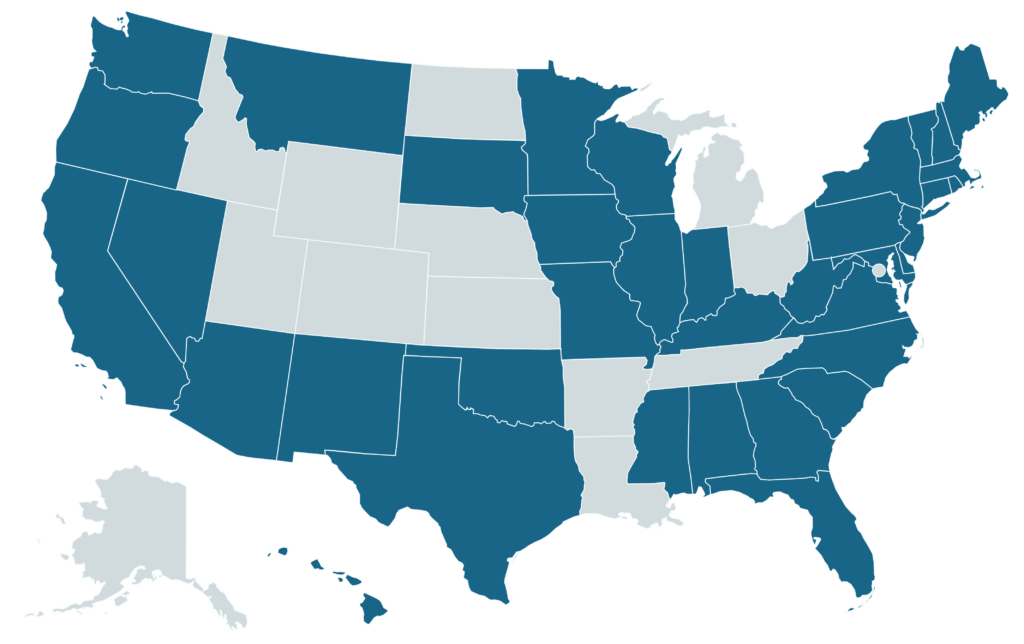
Policy Update
Confronting Forever Chemicals: States Continue to Lead the Way in 2025
May 6, 2025
Overview
Building on state-led momentum from recent years, more states across the country are advancing legislation in 2025 to address the use and harms of PFAS “Forever Chemicals.” So far this year, at least 203 bills have been introduced in 37 states to curb PFAS use and contamination across a range of sources.
Why It Matters: The Threat of PFAS
PFAS are a class of toxic chemicals widely used in everyday products – from cookware and cosmetics to food packaging, drinking water, and agricultural land. Known as “Forever Chemicals” for their persistence in the environment and the human body, PFAS have been linked to serious health risks, including cancer, reproductive harm, and immune system disruption. States across the political and geographic spectrum have taken the lead in confronting PFAS contamination, and 2025 has seen a surge in legislative action aimed at reducing exposure and improving transparency.
The 2025 State of Play: Which States Are Moving PFAS Bills?
Of the 37 states that have introduced PFAS legislation in 2025, at least 19 have advanced their bills out of the committee stage, with New Mexico and Virginia having enacted bills into law. Overall, the states that have introduced PFAS bills in 2025 focus on reducing PFAS exposure across four primary sources: (1) consumer products, (2) firefighting materials, (3) biosolids and pesticides, and (4) water systems.

Consumer Products
States are taking broad action to eliminate PFAS in a range of consumer products, aiming to curb widespread exposure from items used in daily life.
- Comprehensive Restrictions: New Mexico’s newly enacted law (HB 212) will regulate PFAS by prohibiting the sale of certain products with intentionally added PFAS starting between 2027 and 2029, and requiring manufacturers to disclose PFAS use. Bills in states like Hawaii (SB683) and Illinois (HB2516) would restrict the use of PFAS in multiple consumer categories, including food packaging, cookware, and dental floss.
- Children’s Products: Bills from Illinois (HB2516), Massachusetts (H.384), and Vermont (H.238) look to address PFAS in children’s products – such as toys, clothing, and school supplies – to reduce exposure among young and highly sensitive groups.
- Outdoor Gear: States with robust outdoor recreation economies are seeking to address PFAS in outdoor gear and equipment, including New Hampshire (HB167) and Vermont (H.238), which would prohibit PFAS from being added to items like skis, boats, boards, or water-resistant textile materials.
- Beauty and Menstrual Products: Many states are increasing their focus on removing PFAS and other toxins from cosmetic and menstrual products. These states include California (AB-2515), Connecticut (S.B.884), Florida (SB 1744), Illinois (HB3409), New Jersey (A4767), North Carolina (H686), and New York (S1548/A1502), which recently passed a comprehensive ban on PFAS in menstrual products like tampons.
Firefighting Materials
States are moving swiftly to limit PFAS exposure among first responders by targeting their use in firefighting foam and protective equipment – two major sources of occupational contamination linked to serious health and environmental risks.
- Firefighting PPE: California (AB-1181), Illinois (HB2409), and Rhode Island (H 5019) are advancing bills that would ban the use of intentionally added PFAS materials in firefighting personal protective equipment (PPE).
- Firefighting Foam: Maine (L.D. 222), New York (S3659 A / A1053 A), and Oregon (SB 91) are among the states moving bills to ban the use of PFAS in firefighting foam, in many cases in addition to PPE.
Land Use (Pesticides and Biosolids)
The widespread presence of PFAS in pesticides and biosolids – sewage sludge often used as fertilizer – poses growing risks to human health, soil, and water. An increasing share of states, especially those with significant agricultural sectors, are seeking to limit the presence of PFAS in land and water through these two sources.
- Pesticides: Maryland’s HB0386 would require the Department of Agriculture to identify and publish a list of PFAS-containing pesticides by 2032, after which the use of these pesticides would be prohibited statewide.
- Biosolids: States are increasingly addressing the use of PFAS-contaminated biosolids for various land uses, with Oklahoma (SB 3) seeking to prohibit the land application of biosolids containing PFAS, Washington (SB 5033) seeking to improve testing for PFAS in biosolids, and Iowa (HF723) seeking to allow landowners the right to refuse the application of biosolids on their land if PFAS are detected.
Water Systems
The drinking water of millions of Americans has been found to contain high levels of PFAS, and a variety of states are taking action to get PFAS out of their constituents’ water. Bills in 2025 primarily seek to expand testing requirements and set stricter contamination limits for PFAS in water systems.
- Monitoring and Accountability: Alabama (HB541), Delaware (SB72), and Virginia (HB2050 & SB1319) are among the states that would establish more stringent testing and reporting requirements for PFAS in drinking water systems. North Carolina (H569) and Illinois (HB2955) would make manufacturers more financially responsible for addressing PFAS in water systems.
- Water Quality Standards: States are also seeking to reduce the presence of PFAS in public drinking water and private wells by improving water quality standards relative to PFAS contamination, as seen in legislation introduced in Arizona (SB1391), New York (S3207), Vermont (H.286), and Wisconsin (AB129).
Stay Informed on PFAS Policy With NCEL
Stay up to date on trends in PFAS policy across the country this year with NCEL’s Bill Tracking Map.